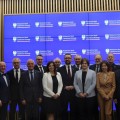Reshaping tradition: good old ways are not always good
Reading time: about 6 minuts

Fluorescence is a well-known phenomenon with many practical applications that has been studied for decades. Despite this, a commonly used mathematical formalism to describe how it evolves over time does not make physical sense under certain conditions, as researchers from the Institute of Physical Chemistry, Polish Academy of Sciences have recently discovered. Namely, they showed that a mathematical tool that can be safely used in solids, where molecules are practically immobile, cannot always be used in liquids, where they can move freely. If applied incorrectly, this widely used approach can lead to erroneous interpretations of experimental data and wrong conclusions. This is what their recent paper in the Journal of Chemical Physics warns us about.
Everything glows, but not in the same way. It has been known for more than a century that anybody at a given temperature above the inaccessible absolute zero emits photons. Some substances also emit light after undergoing a chemical or biochemical reaction, an electrochemical reaction, or after being excited by another light source. These phenomena are known as chemi-, bio-, electrochemi- and photo-luminescence, respectively. You may have seen photos of Australian coastlines full of bright blue algae at night, or glowing fireflies in the forest. You may have noticed the green and blue flakes in banknotes under an ultraviolet lamp. In all these examples, the observed light is a luminescence process in which molecules in excited states of their electrons relax back to the comfortable relaxed state, giving off the excess energy in the form of photons, and not just heating up their environment.
This phenomenon of luminescence was first described in Europe in the 16th century by Nicolas de Monardes: lucky enough to be at the center of the world at the time, he received some wood samples from Mexico that, when soaked in alkaline water, glowed blue. The Americans had known for a long time that this was a sign of a well-prepared medicine against kidney diseases from a certain plant known to Monardes as Lignum nephriticum. Today, luminescence, in particular fluorescence, is used intensively for the same purpose: to report on the structure and properties of biological samples. Fluorescence microscopy techniques have evolved to the point where single molecules can be observed.
An interesting characteristic of fluorescent samples is that the duration of light emission depends on many external factors. Therefore, not only the color of the emission is used in the above applications, but also its temporal decay. In the simplest case, this fluorescence decay is well described by an exponential function. This is analogous to the exponential decay of the intensity of ionizing radiation (alpha, beta, or gamma) emitted by a sample containing a single type of radioactive isotope.
It is often observed that when the sample is structurally complex, non-homogeneous or very viscous, a simple mathematical function such as the exponential is not sufficient to describe the temporal evolution of fluorescence. Sometimes a sum of several such functions is sufficient. If the complexity is high enough, the number of these functions can be very large, so it makes more sense to use continuous distributions of decays. This is a very elegant formalism that can provide a lot of insight into the structure of the environment in which the fluorescent species is embedded. For example, in a living cell, a fluorophore (our little reporter) might be located in places in the membrane, or in the citoplasm, or in the mitochondria, or attached to some proteins... All these different environments will affect the properties of the fluorophore in such a way that its luminescent relaxation will vary, leading to slightly different colors of luminescence with distinct decay times.
One important phenomenon that occurs to excited molecules is called quenching. This is usually a chemical reaction that impedes the molecules from emitting light, reducing, quenching, the total amount of light observed from the sample. This also shortens the observed duration of the fluorescent glow: it is then said that the decay kinetics are affected by quenching.
Merging both scenarios, complex environments and quenching by chemical reactions with other substances, is not an easy thing to study, but it happens all the time. One might be tempted to use the same sums of exponential functions or continuous distributions of lifetimes to explain the observations. Until now, we did not know that this was wrong:
"...we have shown that this mathematical approach has a clear physical interpretation only when the fluorophore and quencher molecules are stationary, as in the solid state. However, if we consider the mobility of the fluorophore with respect to the quencher, such an interpretation becomes impossible. Therefore, for systems in which the relative motion of fluorophores and quenchers cannot be ignored, it is not appropriate to use the time-independent rate or decay time distributions to explain, fit, or rationalize experimental results on fluorescence decay". - says Prof. Gonzalo Angulo of ICP PAS.
In addition, ICP PAS scientists have provided a new insight into the description of molecular systems where the relative motion of fluorophore and quencher is taken into account. They have shown that it is possible to use a theoretical approach to predict the time-dependent decay rate distribution, provided that the initial microscopic properties of the system, such as the distribution of quenchers around the fluorophore and the microscopic transfer rates, are known. Such a time-dependent distribution can correctly describe fluorescence decay even in the presence of molecular motion.
As is usually the case in theoretical studies, a few simplifying assumptions were made:
"First, we assumed that the quenchers interact with a fluorophore but do not "feel" each other: their interactions are neglected. Furthermore, although we considered the fluorophore-quencher excluded volume - through the presence of the pair distribution function - we neglected the quencher-quencher excluded volume effect. Therefore, we can assume that the quencher positions are independent.“ - says dr. Jakub Jędrak. However, he emphasizes that the main result is very general and does not depend on the presence and exact form of interactions between molecules in solution.
Their results show how important it is to re-examine existing theories and models and to look at well-studied assumptions. So there is still a lot of work to be done, even if we think that everything is well studied and well known.
This research published in the J. Chem. Phys. was supported by the National Science
Center OPUS Grant No. 2019/33/B/ST4/01443.
CONTACT:
Prof. Gonzalo Angulo
Institute of Physical Chemistry, Polish Academy of Sciences
Phone: +48 22 343 1086
e-mail: gangulo@ichf.edu.pl
ARTICLE:
"Limitations of the rate-distribution formalism in describing luminescence quenching in the presence of diffusion”
Jakub Jędrak, Gonzalo Angulo
J.Chem. Phys. 161, 2024, 104112
https://doi.org/10.1063/5.0223438
- Author: Dr Magdalena Osial
- Contact: magdalena@osial.eu
- Photo source: Grzegorz Krzyzewski
- Date: 13.12.2024







